SHARING IMAGES
Renaissance Prints into Maiolica and Bronze
April 1 through August 5, 2018
NATIONAL GALLERY OF ART
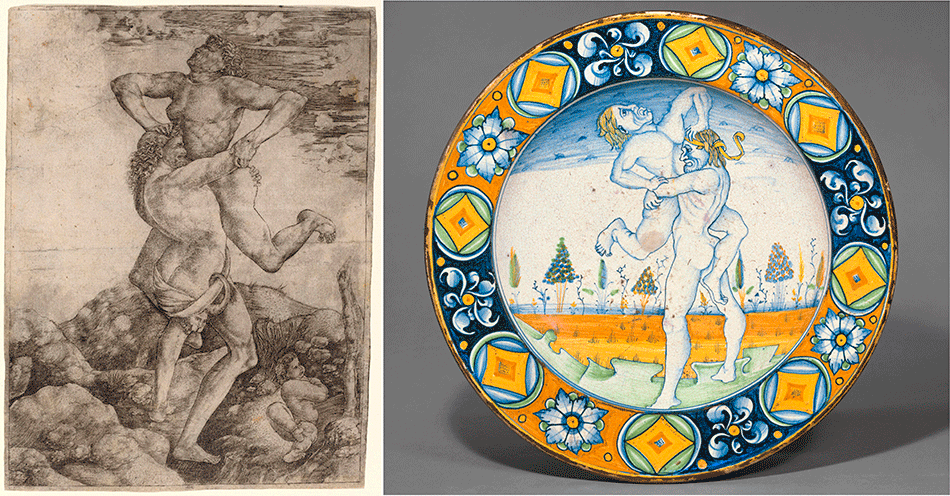 LEFT: Cristofano Robetta, after Antonio del Pollaiuolo. “Hercules and Antaeus”, c. 1500, engraving on laid paper sheet (trimmed to plate mark): 26.7 x 19.9 cm (10 1/2 x 7 13/16 in.) National Gallery of Art, Washington, Gift of the Arcana Foundation.RIGHT: Deruta 16th Century. Dish with “Hercules and Antaeus”, c. 1490–1500, tin-glazed earthenware (maiolica) diameter: 43 cm (16 15/16 in.) The Metropolitan Museum of Art, Robert Lehman Collection, 1975 (1975.1.1033) The Metropolitan Museum of Art / Art Resource, NY.
LEFT: Cristofano Robetta, after Antonio del Pollaiuolo. “Hercules and Antaeus”, c. 1500, engraving on laid paper sheet (trimmed to plate mark): 26.7 x 19.9 cm (10 1/2 x 7 13/16 in.) National Gallery of Art, Washington, Gift of the Arcana Foundation.RIGHT: Deruta 16th Century. Dish with “Hercules and Antaeus”, c. 1490–1500, tin-glazed earthenware (maiolica) diameter: 43 cm (16 15/16 in.) The Metropolitan Museum of Art, Robert Lehman Collection, 1975 (1975.1.1033) The Metropolitan Museum of Art / Art Resource, NY.
First exhibition of its kind in the United States
90 objects to highlight the impact of Renaissance prints on maiolica and bronze plaquettes. It traces the metamorphosis that designs by Andrea Mantegna, Antonio del Pollaiuolo, Raphael, Michelangelo, Parmigianino, and Albrecht Dürer, among others, underwent across these different media. Arranged chronologically, this exhibition is inspired by the acquisition of the William A. Clark maiolica collection from the Corcoran Gallery of Art and draws largely on the Gallery’s newly expanded holdings of early Italian prints (founded on the Lessing Julius Rosenwald gift and augmented by recent acquisitions), as well as on the world-renowned Samuel Henry Kress collection of plaquettes and medals.
Sharing Images tells a story
How printed images were transmitted, transformed, and translated onto ceramics and small bronze reliefs, creating a shared visual canon across artistic media and geographical boundaries. Often acknowledged, but rarely studied in depth, the impact of prints on other media is most visible in Renaissance maiolica (tin-glazed ceramics) and bronze plaquettes.
Fifteenth-century Europe was a place of technological revolution, particularly in the parallel development of printed books and images. These developments transformed the ways in which verbal and visual information could be accessed, with radical implications on cultural, scientific, and artistic production. As easily produced multiples, prints traveled widely. They were frequently copied by artists and craftsmen and were a driving force in the revolution of the arts of the Renaissance.
Small bronze reliefs, known as plaquettes, functioned primarily as refined ornaments or collectibles—a format influenced by ancient carved gems, coins, and statues—first appeared in Rome around 1440. As small, portable objects meant to be handled and privately enjoyed, plaquettes were similar to prints and often produced in or near important printmaking centers, such as Mantua, Bologna, or Venice.
HIGHLIGHTS
On view in the exhibition is Andrea Briosco’s (1470–1532) plaquette “Judith with the Head of Holofernes” (early 16th century), alongside the print that inspired it, Judith with the Head of Holofernes (c. 1480), by a follower of Andrea Mantegna. Briosco responds to Mantegna’s figural style by reducing it to a three-dimensional handheld object, creating an intimate, tactile encounter with the image.
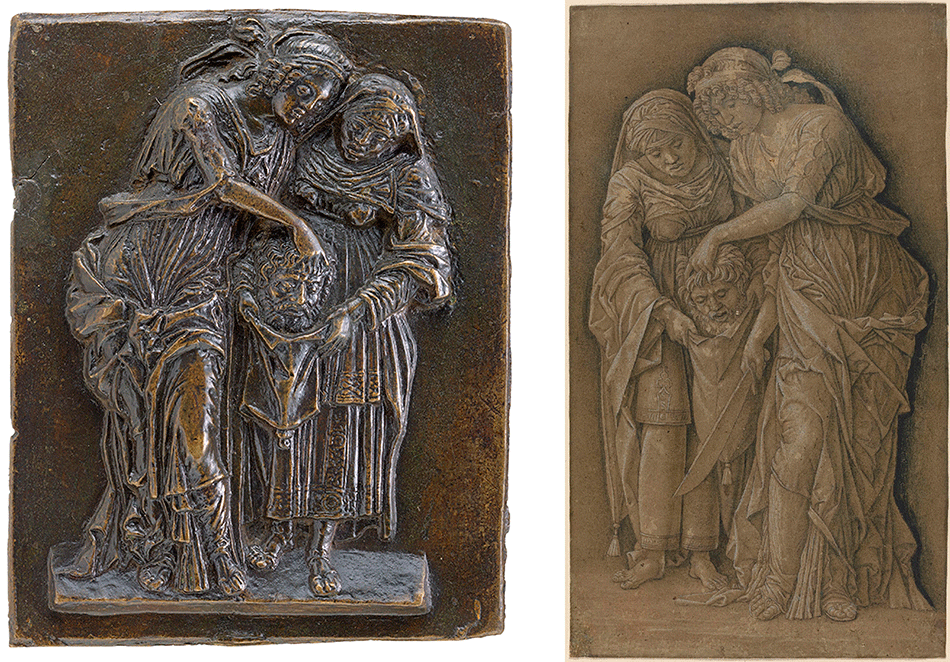
LEFT: Andrea Briosco, called Riccio, “Judith with the Head of Holofernes”, early 16th century, bronze, overall: 10.7 x 8.4 cm (4 3/16 x 3 5/16 in.) gross weight: 357 gr. National Gallery of Art, Washington, Samuel H. Kress Collection.RIGHT: Follower of Andrea Mantegna, “Judith with the Head of Holofernes”, c. 1480, pen and dark brown ink with black chalk and white heightening on olive-brown prepared paper laid down on canvas, overall: 34.8 x 20.2 cm (13 11/16 x 7 15/16 in.) National Gallery of Art, Washington, Samuel H. Kress Collection
Also on view are three plaquettes by one of the masters of the medium, Moderno (Galeazzo Mondella, 1467–1528): The Flagellation, The Entombment, and Hercules and Antaeus (all dating from the late 15th to early 16th century).
 Moderno,
Moderno,
“The Flagellation”,
late 15th–early 16th century,
bronze//Dark brown patina,
overall: 13.5 x 9.9 cm
(5 5/16 x 3 7/8 in.)
gross weight: 397 gr.
National Gallery of Art,
Washington,
Samuel H. Kress Collection
 Moderno
Moderno
“The Entombment”
late 15th–early 16th century
bronze
overall: 1062 x 692.5 cm
(418 1/8 x 272 5/8 in.)
gross weight: 158 gr
National Gallery of Art,
Washington,
Samuel H. Kress Collection
 Moderno
Moderno
“Hercules and Antaeus”
late 15th–early 16th century
bronze//Very dark patina
overall: 7.5 x 5.9 cm
(2 15/16 x 2 5/16 in.)
gross weight: 60 gr
National Gallery of Art,
Washington,
Samuel H. Kress Collection
The Storiato
Inspired by the availability of new pigments, glazes, and printed models, ceramics artists developed a style of decoration called “istoriato” that featured recognizable subjects and narrative episodes from classical and contemporary literature as well as biblical and ancient history. For the first time, pottery painters conceived of the surfaces of plates and vessels as a medium to depict stories in full color and vivid detail.
Like prints, istoriato mirrored and visualized the interests and passions of the cultured elite while remaining accessible to a wider market.
Painters in the principal cities of “istoriato” production—Faenza, Urbino, Pesaro, Gubbio—could respond to the most recent developments in contemporary art thanks to the availability of printed images created in major artistic centers.
The earliest examples of Umbrian “istoriato”, the Deruta plate illustrates how quickly artists could respond to Antonio Pollaiuolo’s (1431/2–1498) innovative and dramatic compositions of the male nude body in motion even in relatively more conservative centers.
While artists in the above cities were early adopters of printed material as sources, those in Deruta, with notable exceptions, remained attached to the style and works of local painters such as Pietro Perugino (c. 1450–1523) and Pinturicchio (1454–1513) until the mid-16th century. One such exception, Dish with “Hercules and Antaeus” (c. 1490–1500)—a spectacular Deruta plate on view in the exhibition—depicts the interlocked bodies of the two subjects dynamically engaged in combat.
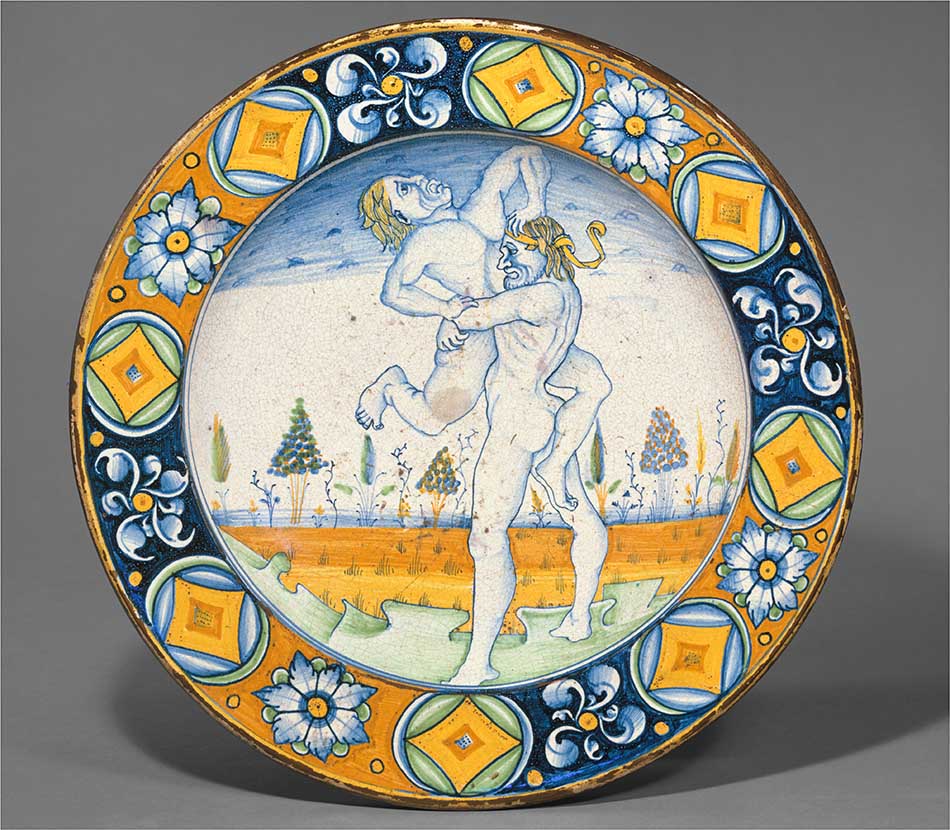 Deruta 16th Century. Dish with “Hercules and Antaeus”, c. 1490–1500, tin-glazed earthenware (maiolica) diameter: 43 cm (16 15/16 in.) The Metropolitan Museum of Art, Robert Lehman Collection, 1975 (1975.1.1033) The Metropolitan Museum of Art / Art Resource, NY
Deruta 16th Century. Dish with “Hercules and Antaeus”, c. 1490–1500, tin-glazed earthenware (maiolica) diameter: 43 cm (16 15/16 in.) The Metropolitan Museum of Art, Robert Lehman Collection, 1975 (1975.1.1033) The Metropolitan Museum of Art / Art Resource, NY
After ALBRECHT DÜRER
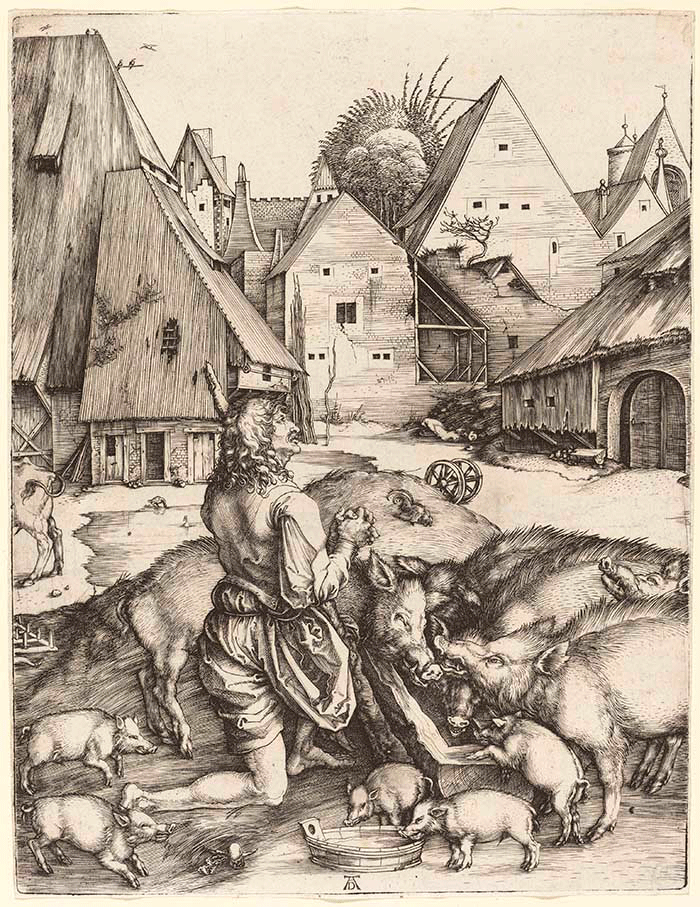
Albrecht Dürer,
“The Prodigal Son”,
c. 1496, engraving sheet
(trimmed to plate mark):
24.8 x 10 cm
(9 3/4 x 3 15/16 in.)
National Gallery of Art, Washington,
Rosenwald Collection.
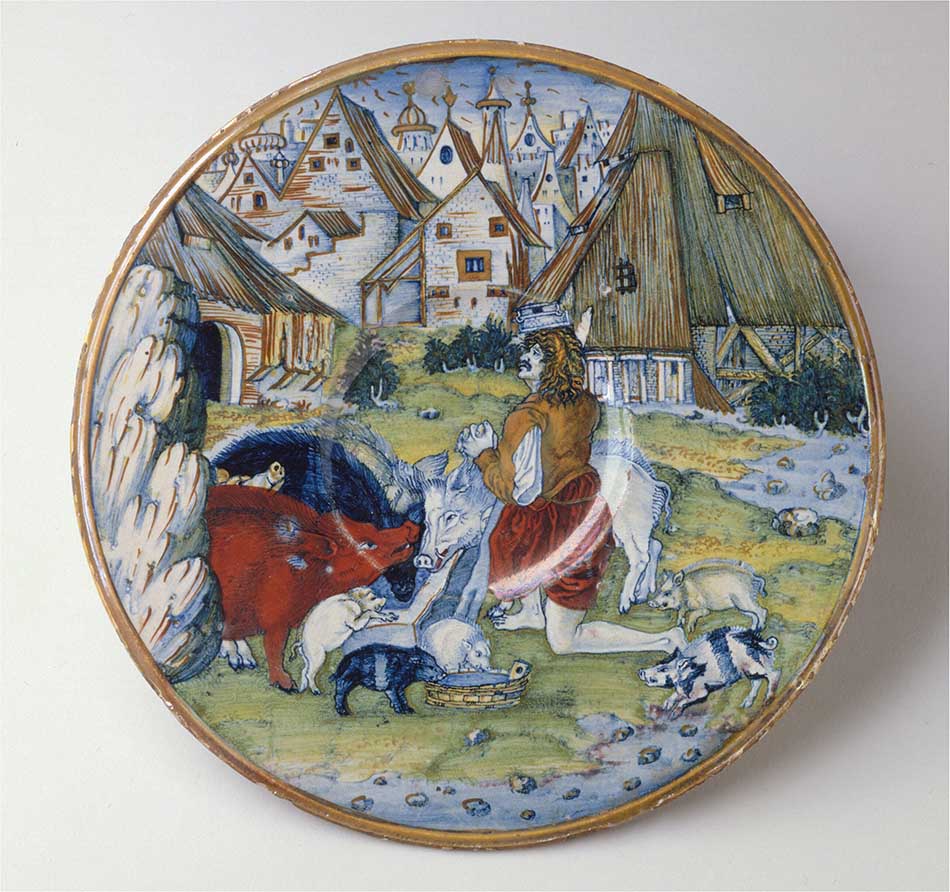 “Dish with the Prodigal Son”, Workshop of Maestro Giorgio Andreoli of Gubbio, 1525, tin-glazed earthenware (maiolica) diameter: 28.3 cm (11 1/8 in.) The Metropolitan Museum of Art, Robert Lehman Collection, 1975 (1975.1.1105)
“Dish with the Prodigal Son”, Workshop of Maestro Giorgio Andreoli of Gubbio, 1525, tin-glazed earthenware (maiolica) diameter: 28.3 cm (11 1/8 in.) The Metropolitan Museum of Art, Robert Lehman Collection, 1975 (1975.1.1105)
After MICHELANGELO BUONARROTI
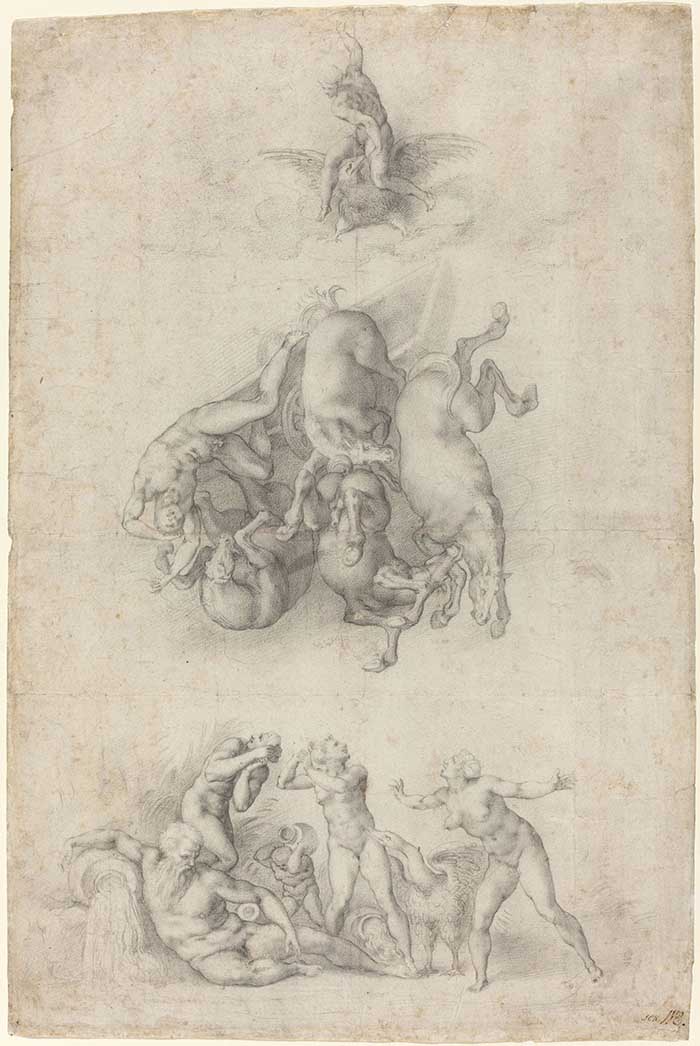
Agnolo Bronzino
or Giulio Clovio
after Michelangelo
“The Fall of Phaethon” 1555/1559
black chalk on
laid paper
overall: 40.7 x 27.2 cm
(16 x 10 11/16 in.)
National Gallery of Art, Washington
Woodner Collection
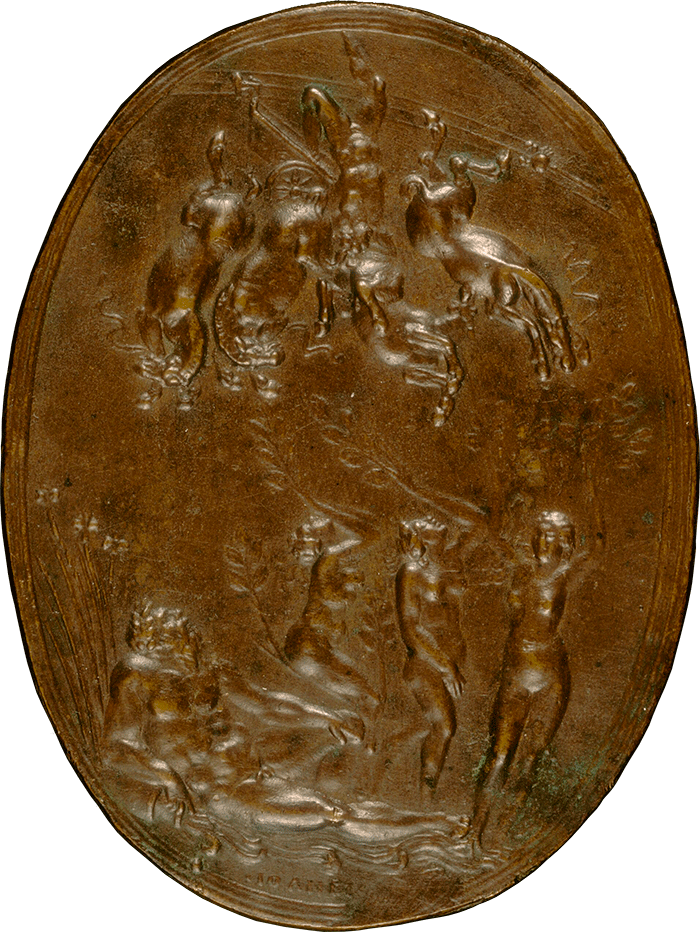
Giovanni Bernardi
“The Fall of Phaeton”
1533 or after
bronze//Medium
brown patina
overall (oval): 9 x 6.8 cm
(3 9/16 x 2 11/16 in.)
gross weight: 116 gr
National Gallery of Art, Washington
Samuel H. Kress Collection
After RAPHAEL
Marcantonio Raimondi after Raphael, “The Massacre of the Innocents”
c. 1511, engraving sheet (trimmed within plate mark): 28.1 x 43.4 cm (11 1/16 x 17 1/16 in.)
National Gallery of Art, Washington, Print Purchase Fund (Rosenwald Collection)
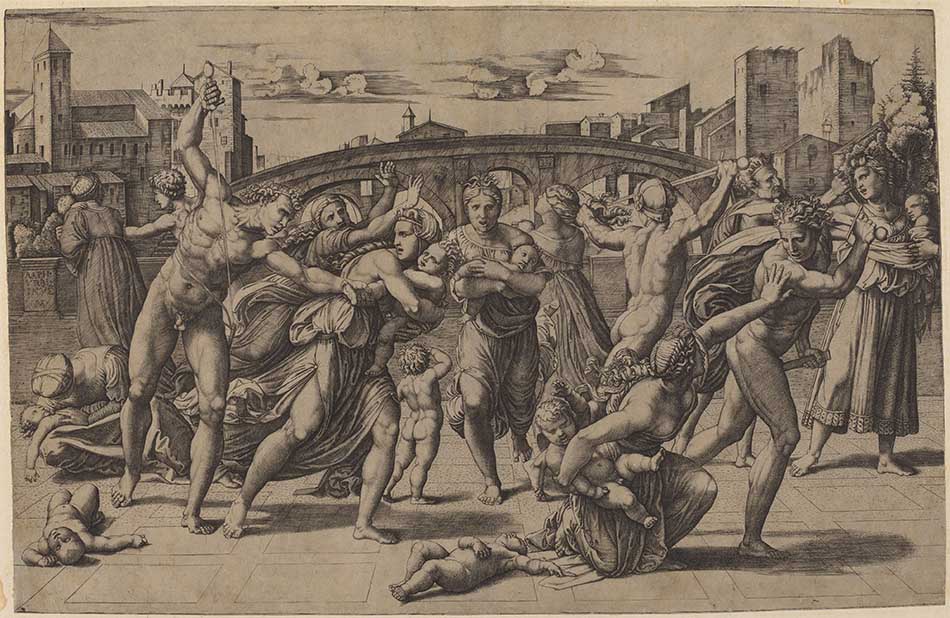
Nicolaus Beatrizet (?) after Marco Dente, after Baccio Bandinelli, “The Massacre of the Innocents”1540s(?) engraving on laid paper sheet: 31.1 x 41.3 cm (12 1/4 x 16 1/4 in.), trimmed within platemarkNationals Gallery of Art, Washington, Ailsa Mellon Bruce Fund
and Purchased as the Gift of Robert B. Loper
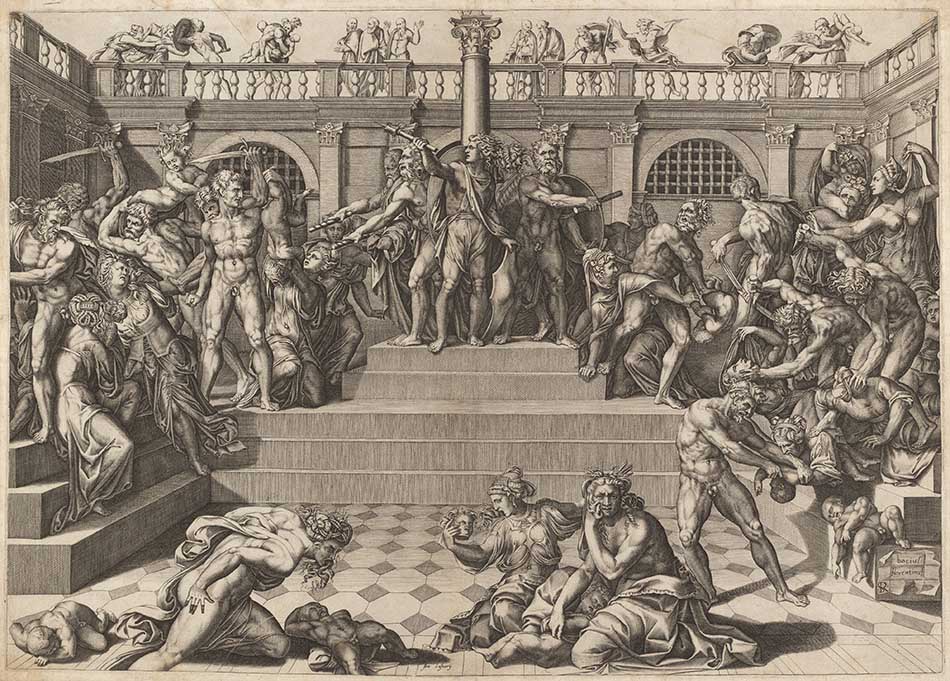
 Francesco Xanto Avelli, “Charger with the Massacre of the Innocents”, c. 1527/1530, Tin-glazed earthenware (maiolica) overall (diameter): 48.58 cm (19 1/8 in.) National Gallery of Art, Washington, Corcoran Collection (William A. Clark Collection)
Francesco Xanto Avelli, “Charger with the Massacre of the Innocents”, c. 1527/1530, Tin-glazed earthenware (maiolica) overall (diameter): 48.58 cm (19 1/8 in.) National Gallery of Art, Washington, Corcoran Collection (William A. Clark Collection)
After PARMIGIANINO
Gian Jacopo Caraglio after Parmigianino, “The Adoration of the Shepherds”
c. 1526, engraving, height: 20.5 x 23.8 cm (8 1/16 x 9 3/8 in.)Kirk Edward Long Collection
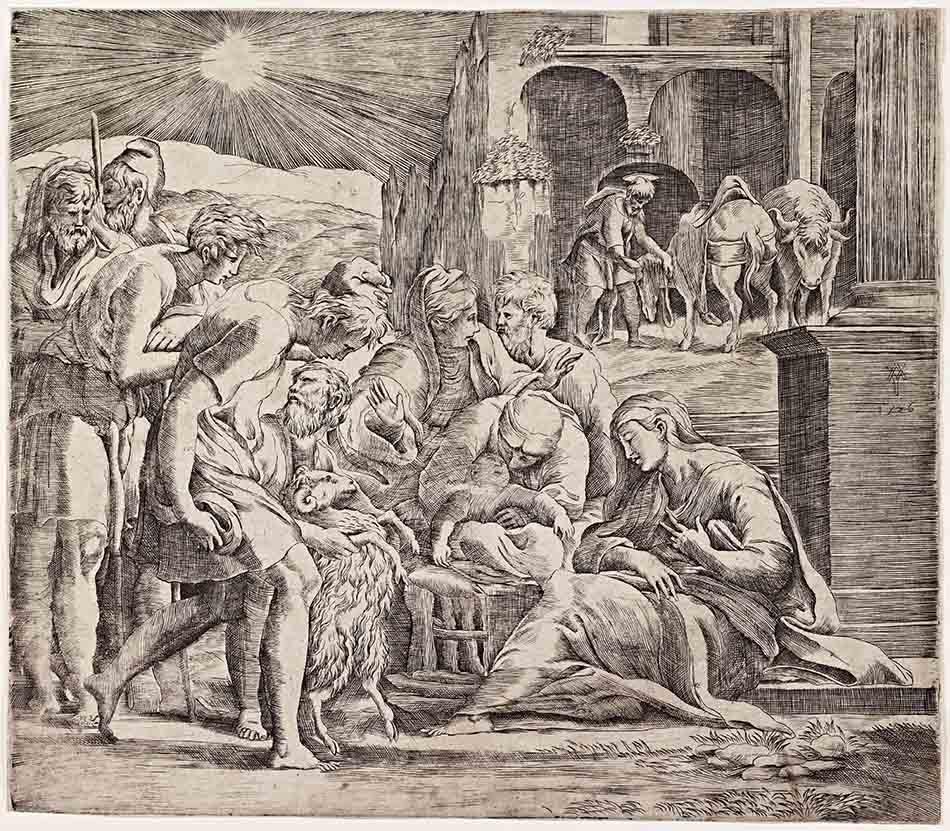
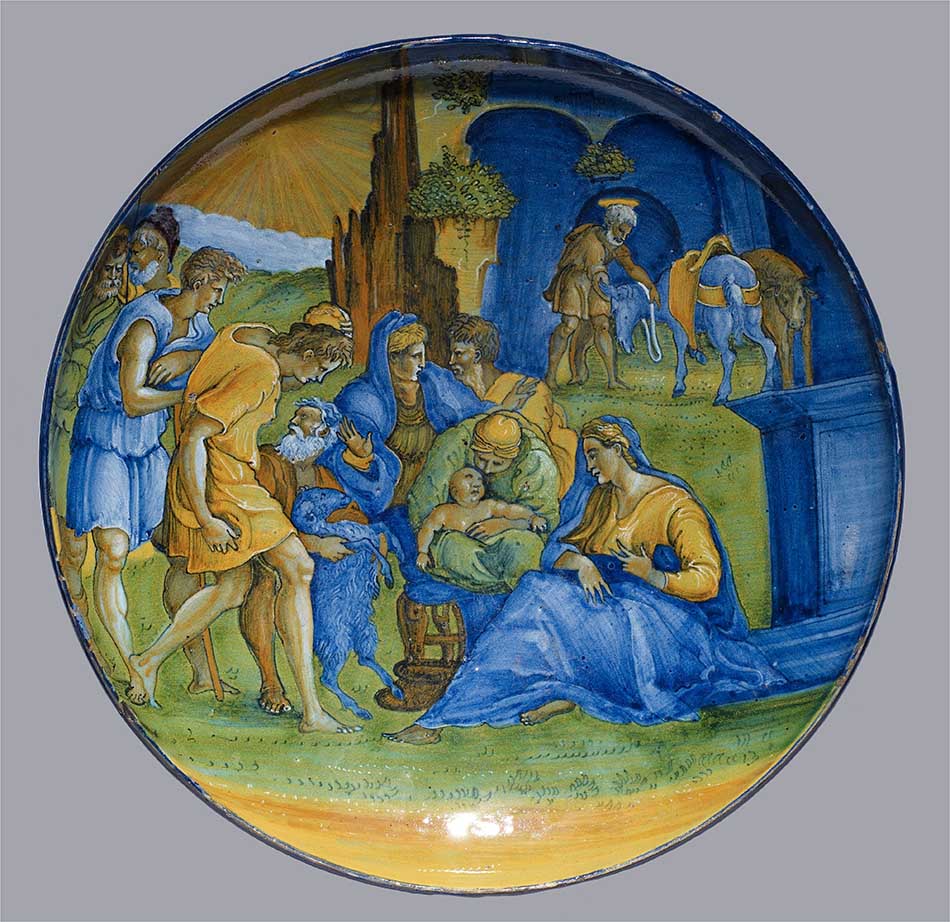 Gian Jacopo Caraglio, “Dish with the Adoration of the Shepherds”, c. 1530–1540, tin-glazed earthenware (maiolica) diameter: 26 cm (10 1/4 in.) The Walters Art Museum Baltimore, 48.1487
Gian Jacopo Caraglio, “Dish with the Adoration of the Shepherds”, c. 1530–1540, tin-glazed earthenware (maiolica) diameter: 26 cm (10 1/4 in.) The Walters Art Museum Baltimore, 48.1487
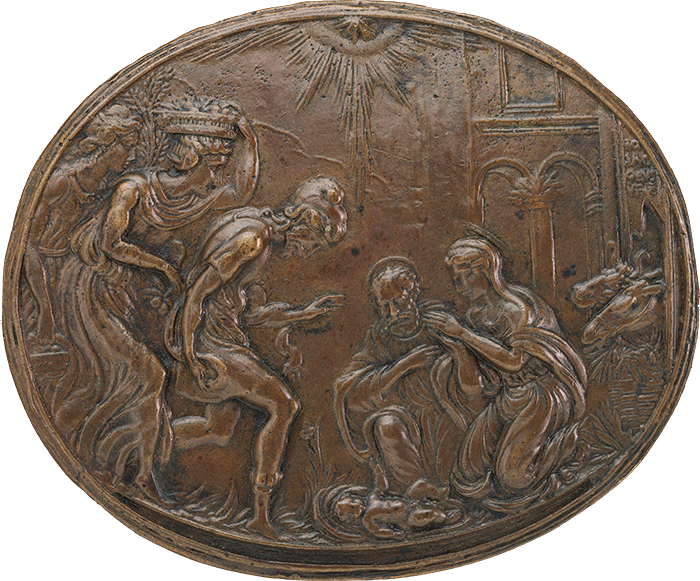
Gian Jacopo Caraglio
“The Adoration of the Shepherds”
c. 1526
bronze,
overall (oval): 7.5 x 9.1 cm
(2 15/16 x 3 9/16 in.)
National Gallery of Art,
Washington
Eugene L. and Marie-Louise Garbáty Fund
After GIAN JACOPO CARAGLIO
Gian Jacopo Caraglio. “The Muses and the Pierides”,
1505–1565, height: 24 x 38.6 cm, (9 7/16 x 15 3/16 in.) Kirk Edward Long Collection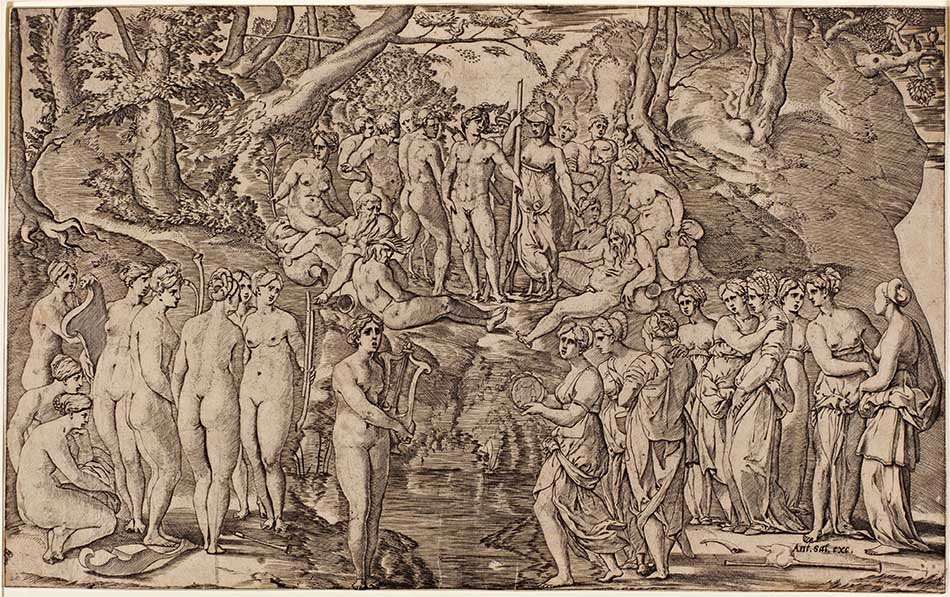
 Unknown 16th Century, “Plate with Muses and Pierides”, 1500–1599, tin-glazed earthenware (maiolica) diameter: 45 cm (17 11/16 in.) Smithsonian American Art Museum, Gift of John Gellatly
Unknown 16th Century, “Plate with Muses and Pierides”, 1500–1599, tin-glazed earthenware (maiolica) diameter: 45 cm (17 11/16 in.) Smithsonian American Art Museum, Gift of John Gellatly
After MARCO DENTE
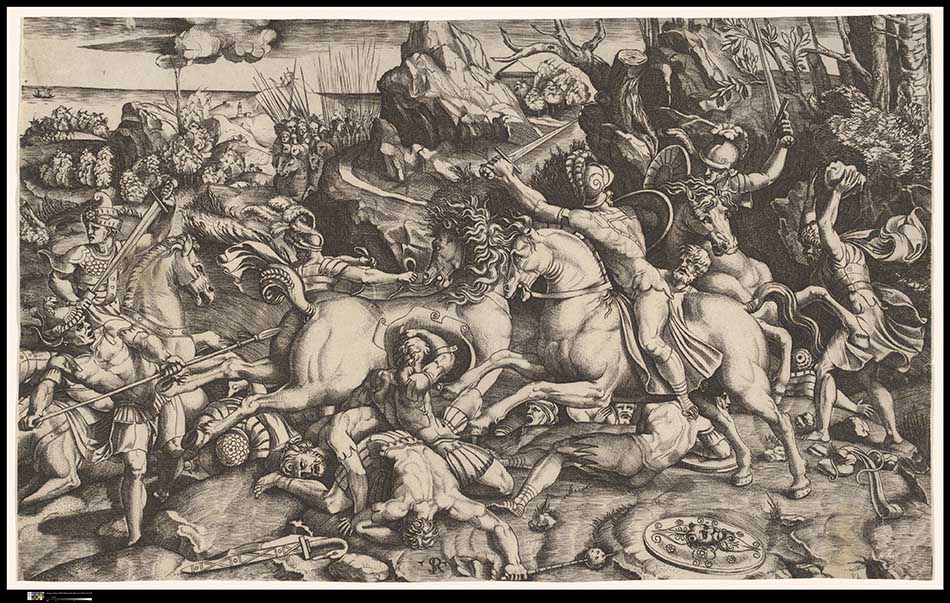 Marco Dente, “Battle Scene”, c. 1520, engraving, sheet: 22.5 x 36.2 cm (8 7/8 x 14 1/4 in.) The Metropolitan Museum of Art, Purchase, Joseph Pulitzer Bequest, 1917 (17.50.16-98) © The Metropolitan Museum of Art / Art Resource, NY
Marco Dente, “Battle Scene”, c. 1520, engraving, sheet: 22.5 x 36.2 cm (8 7/8 x 14 1/4 in.) The Metropolitan Museum of Art, Purchase, Joseph Pulitzer Bequest, 1917 (17.50.16-98) © The Metropolitan Museum of Art / Art Resource, NY
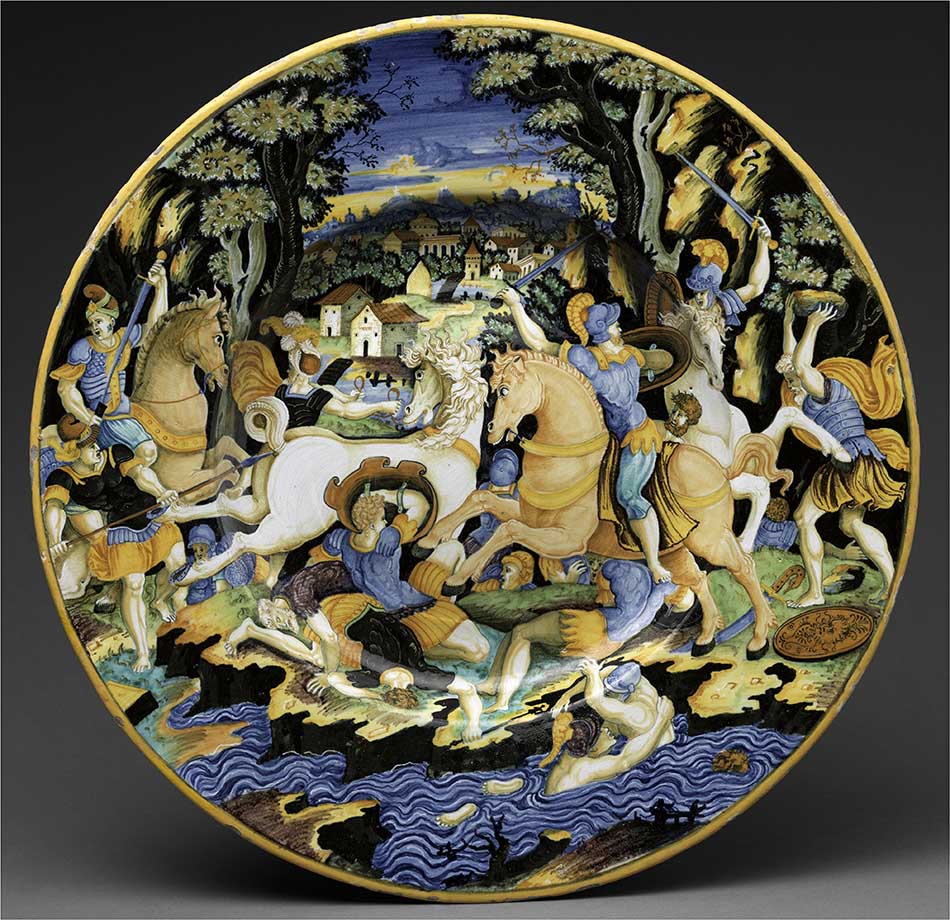 Painter of the Coal Mine Service, “Dish with a Battle Scene”, c. 1540–1545, tin-glazed earthenware (maiolica) overall: 5.7 x 41.4 cm (2 1/4 x 16 5/16 in.) The Metropolitan Museum of Art, The Friedsam Collection, Bequest of Michael Friedsam, 1931 (32.100.369)
Painter of the Coal Mine Service, “Dish with a Battle Scene”, c. 1540–1545, tin-glazed earthenware (maiolica) overall: 5.7 x 41.4 cm (2 1/4 x 16 5/16 in.) The Metropolitan Museum of Art, The Friedsam Collection, Bequest of Michael Friedsam, 1931 (32.100.369)
DERUTA, FAENZA, URBINO
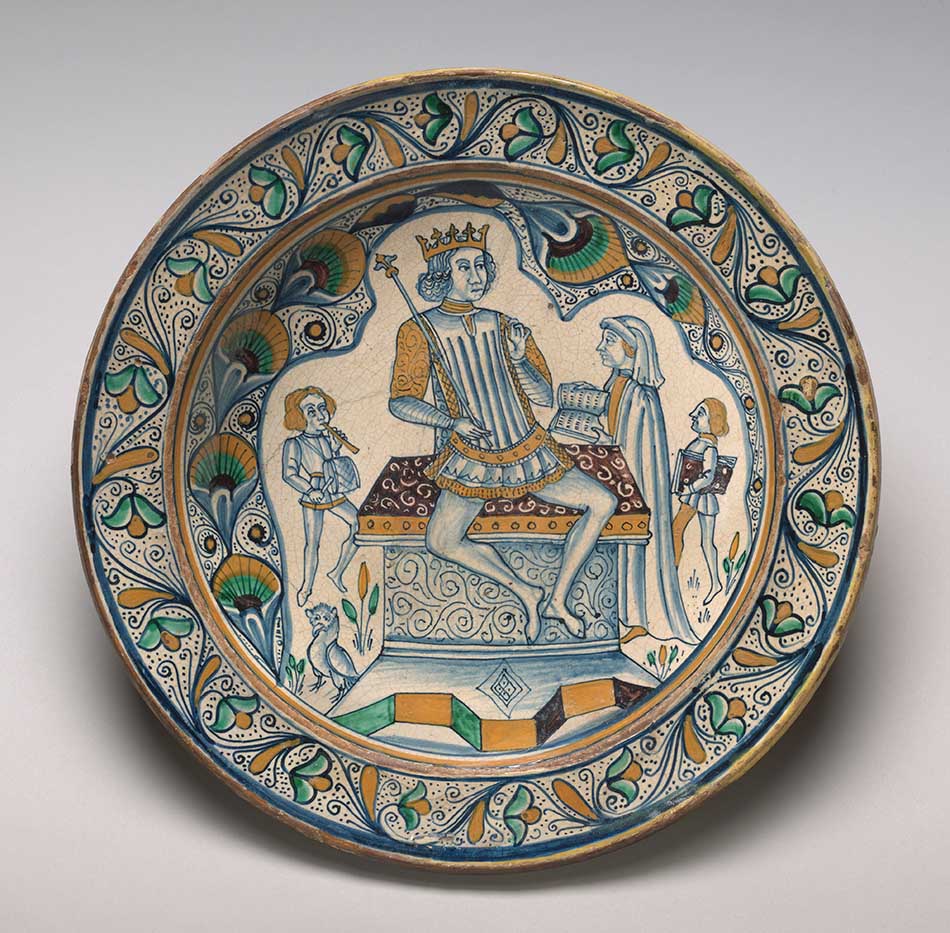 DERUTA or FAENZAoverall (height by diameter): 6.35 x 38.1 cm (2 1/2 x 15 in.) National Gallery of Art, Washington, Corcoran Collection (William A. Clark Collection)
DERUTA or FAENZAoverall (height by diameter): 6.35 x 38.1 cm (2 1/2 x 15 in.) National Gallery of Art, Washington, Corcoran Collection (William A. Clark Collection)
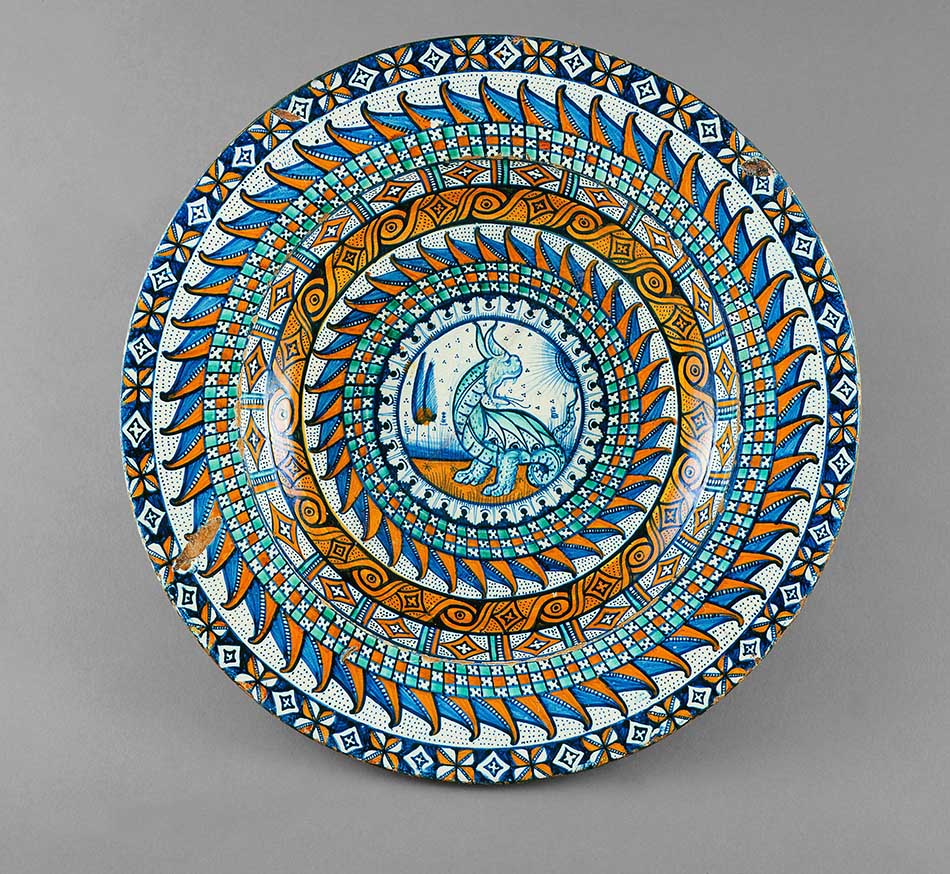 DERUTA or FAENZA, Basin with geometric patterns and dragon, c. 1480/1500, tin-glazed earthenware (maiolica) overall (height by diameter): 4.76 x 38.42 cm (1 7/8 x 15 1/8 in.) National Gallery of Art, Washington, Corcoran Collection (William A. Clark Collection)
DERUTA or FAENZA, Basin with geometric patterns and dragon, c. 1480/1500, tin-glazed earthenware (maiolica) overall (height by diameter): 4.76 x 38.42 cm (1 7/8 x 15 1/8 in.) National Gallery of Art, Washington, Corcoran Collection (William A. Clark Collection)
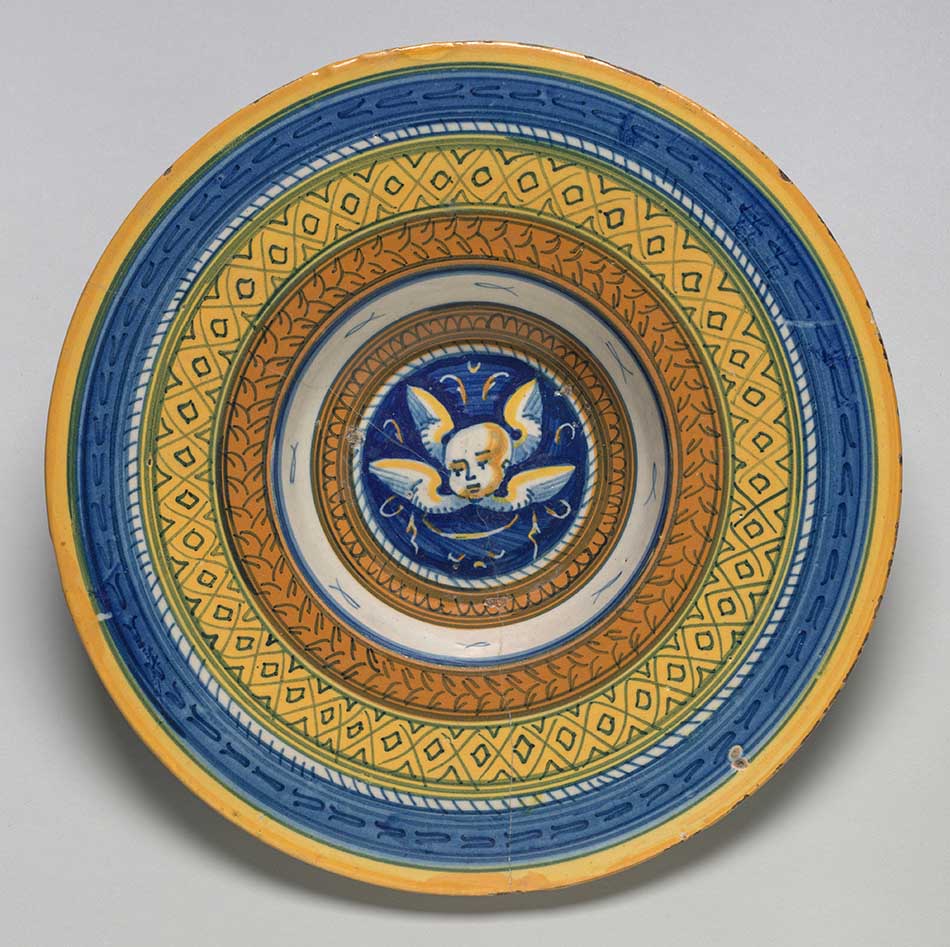 FAENZA, Plate with seraph, early 16th century, tin-glazed earthenware (maiolica) overall: 3.81 x 23.5 cm (1 1/2 x 9 1/4 in.) National Gallery of Art, Washington, Corcoran Collection (William A. Clark Collection)
FAENZA, Plate with seraph, early 16th century, tin-glazed earthenware (maiolica) overall: 3.81 x 23.5 cm (1 1/2 x 9 1/4 in.) National Gallery of Art, Washington, Corcoran Collection (William A. Clark Collection)
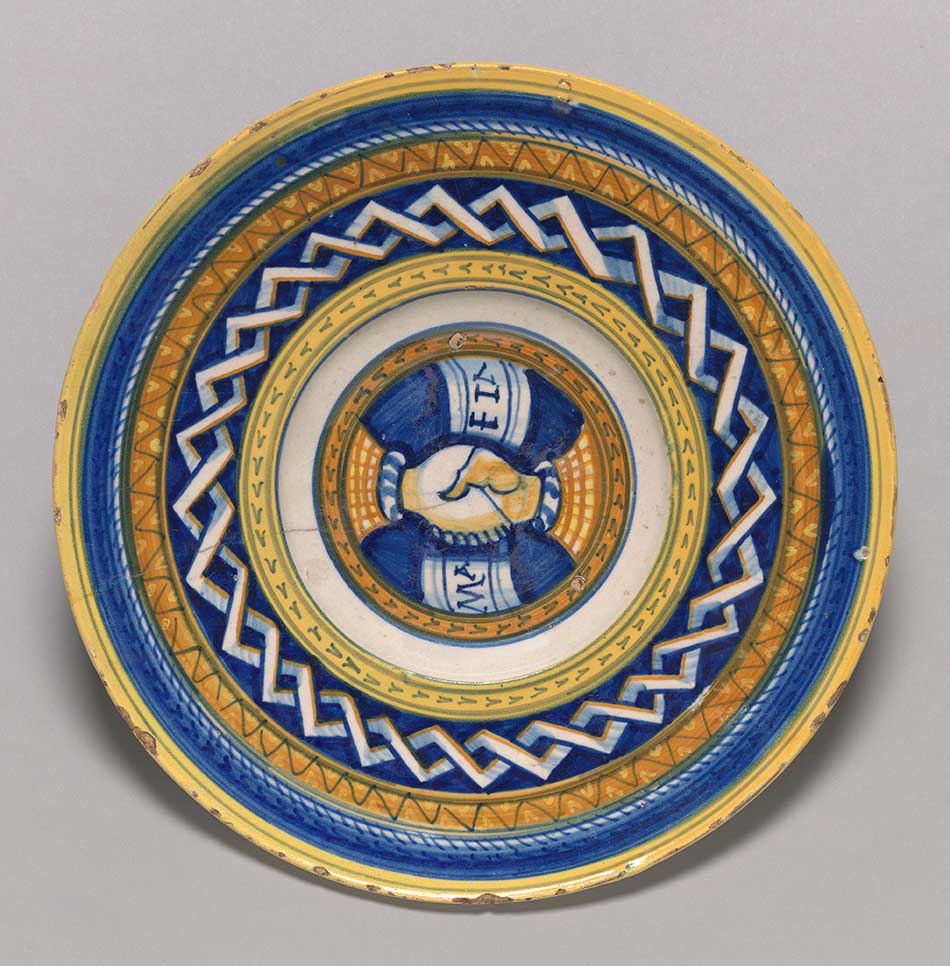 FAENZA. Plate with clasped hands, late 15th or early 16th century, tin-glazed earthenware (maiolica) overall: 2.54 x 23.5 cm (1 x 9 1/4 in.) National Gallery of Art, Washington, Corcoran Collection (William A. Clark Collection)
FAENZA. Plate with clasped hands, late 15th or early 16th century, tin-glazed earthenware (maiolica) overall: 2.54 x 23.5 cm (1 x 9 1/4 in.) National Gallery of Art, Washington, Corcoran Collection (William A. Clark Collection)
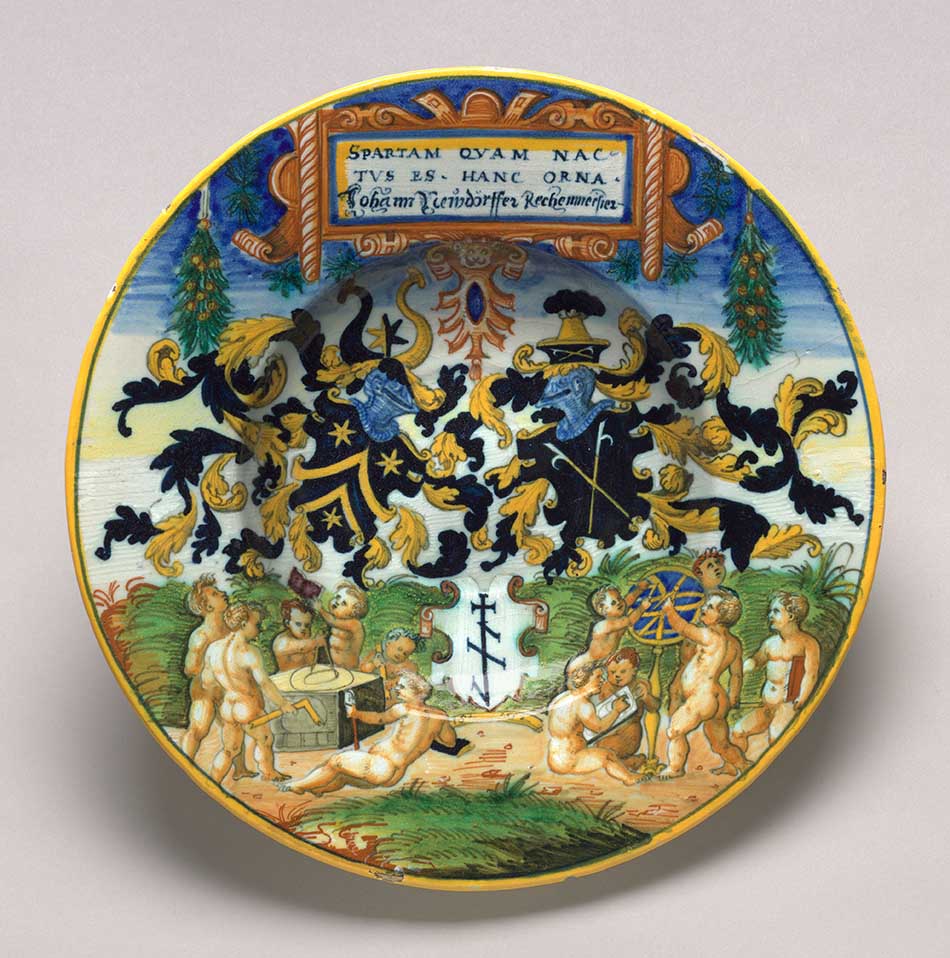 URBINO. Plate with a heraldic design after Hans Sebald Lautensack, c. 1552/1563, tin-glazed earthenware (maiolica) overall: 4.45 x 24.13 cm (1 3/4 x 9 1/2 in.) National Gallery of Art, Washington, Corcoran Collection (William A. Clark Collection)
URBINO. Plate with a heraldic design after Hans Sebald Lautensack, c. 1552/1563, tin-glazed earthenware (maiolica) overall: 4.45 x 24.13 cm (1 3/4 x 9 1/2 in.) National Gallery of Art, Washington, Corcoran Collection (William A. Clark Collection)
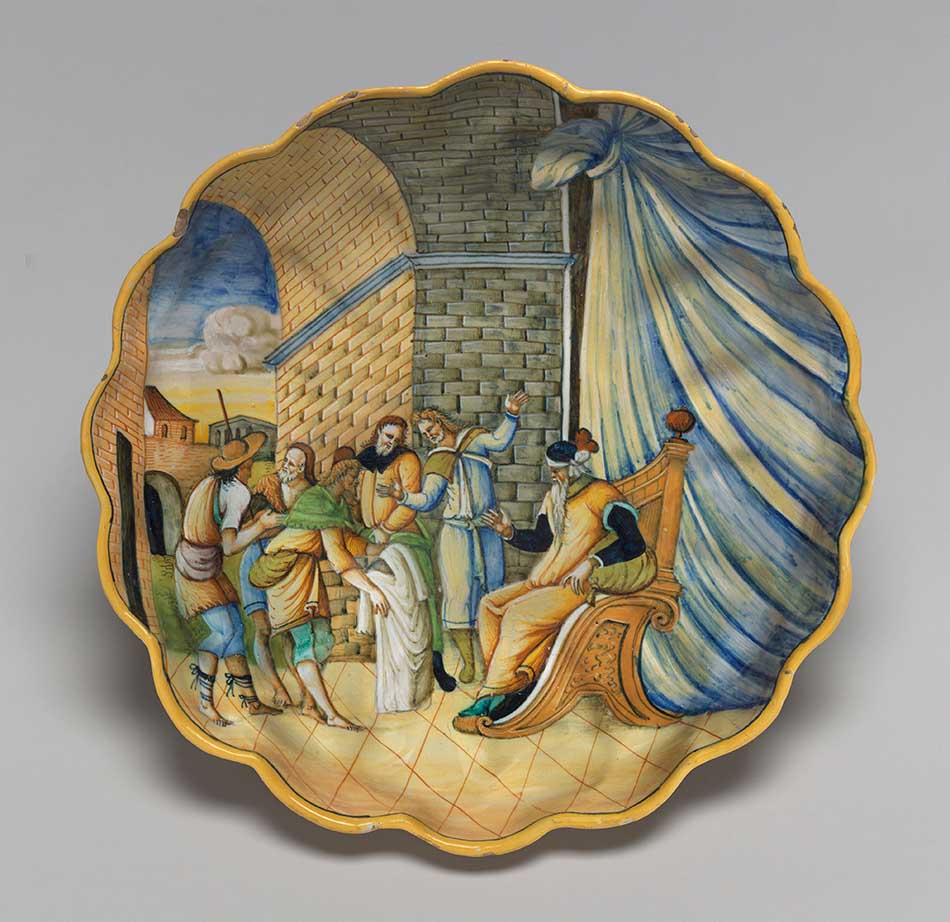 URBINO, or LYON (?) Molded dish with Joseph’s robe being presented to his father, c. 1575/1600, tin-glazed earthenware (maiolica) 27.94 cm (11 in.) National Gallery of Art, Washington, Corcoran Collection (William A. Clark Collection)
URBINO, or LYON (?) Molded dish with Joseph’s robe being presented to his father, c. 1575/1600, tin-glazed earthenware (maiolica) 27.94 cm (11 in.) National Gallery of Art, Washington, Corcoran Collection (William A. Clark Collection)
PRINTS
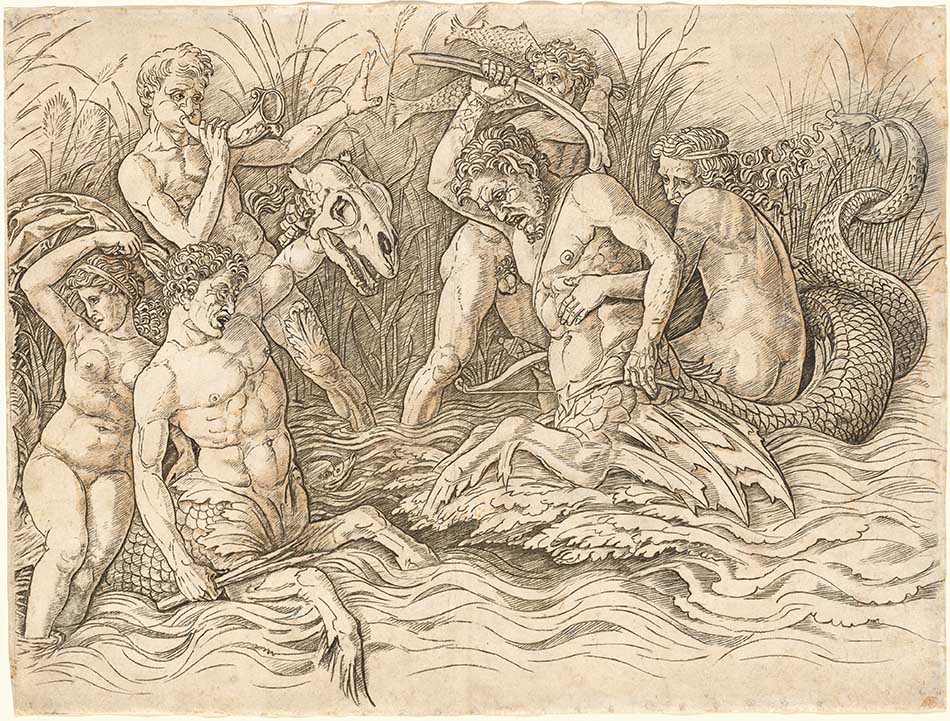 Workshop of Andrea Mantegna, “Battle of the Sea Gods” [right half], c. 1485/1488, engraving, sheet: 28.8 x 38.1 cm (11 5/16 x 15 in.) National Gallery of Art, Washington, Gift of W.G. Russell Allen
Workshop of Andrea Mantegna, “Battle of the Sea Gods” [right half], c. 1485/1488, engraving, sheet: 28.8 x 38.1 cm (11 5/16 x 15 in.) National Gallery of Art, Washington, Gift of W.G. Russell Allen
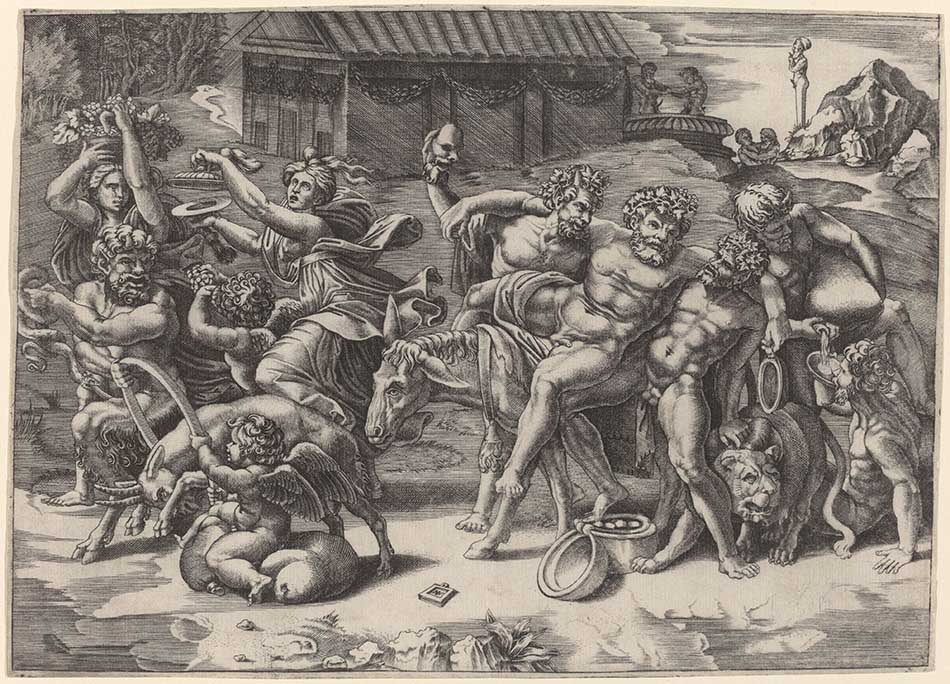 Agostino dei Musi, called Agostino Veneziano, “The March of Silenus”, c. 1520, engraving, 18.4 x 25.7 cm (7 1/4 x 101/8 in.) National Gallery of Art, Washington, Ailsa Mellon Bruce Fund
Agostino dei Musi, called Agostino Veneziano, “The March of Silenus”, c. 1520, engraving, 18.4 x 25.7 cm (7 1/4 x 101/8 in.) National Gallery of Art, Washington, Ailsa Mellon Bruce Fund

Lucas Cranach the Elder
“Marcus Curtius Plunging
into the Chasm”
c. 1506–1507
Woodcut
33.5 x 23.4 cm
(13 1/8 x 9 3/16 in.)
National Gallery of Art,
Washington,
Rosenwald Collection
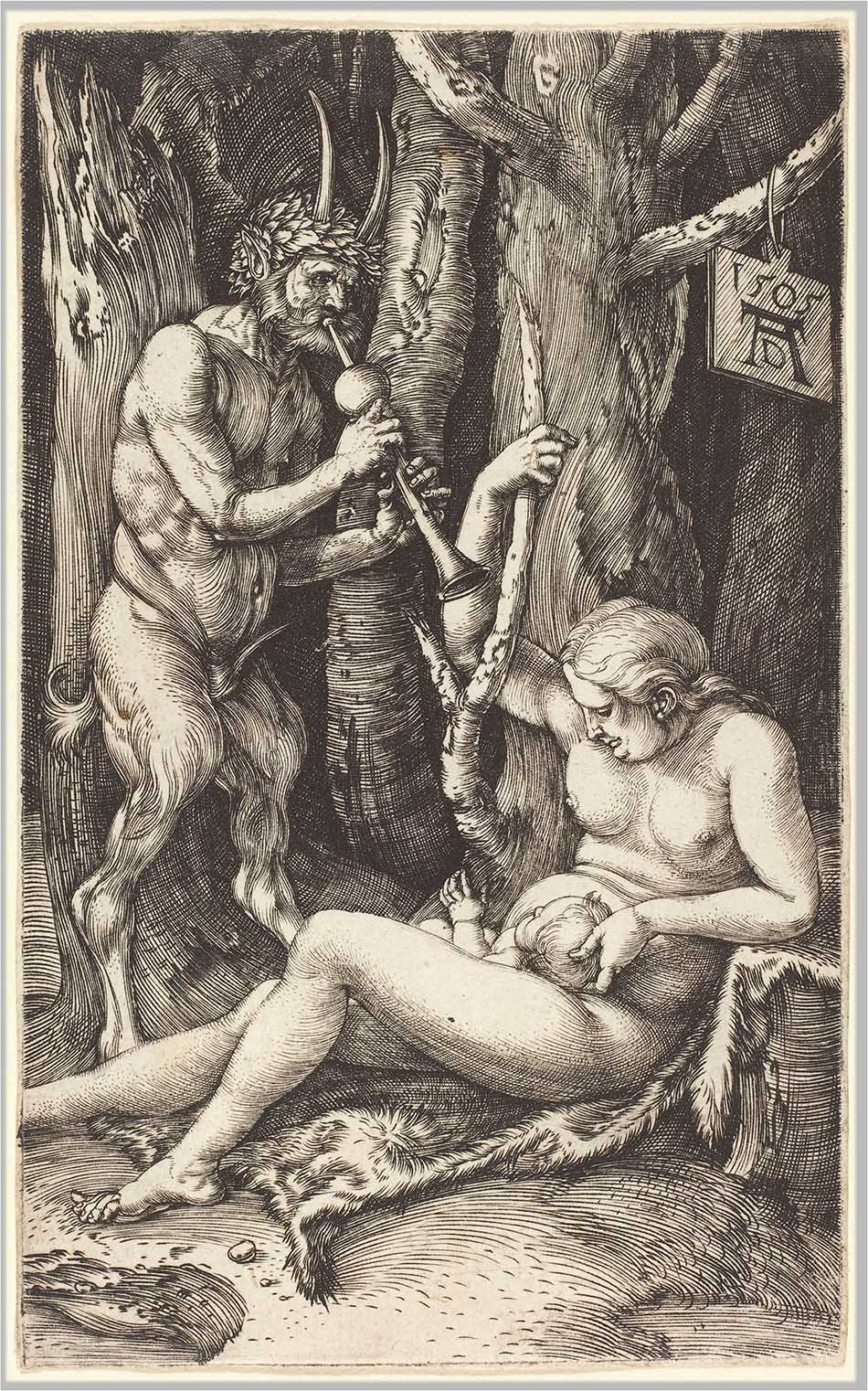
Albrecht Dürer
“Satyr Family”
1505
Engraving on laid paper
sheet (trimmed to plate mark):
11.6 x 7.1 cm
(4 9/16 x 2 13/16 in.)
National Gallery of Art,
Washington,
Rosenwald Collection
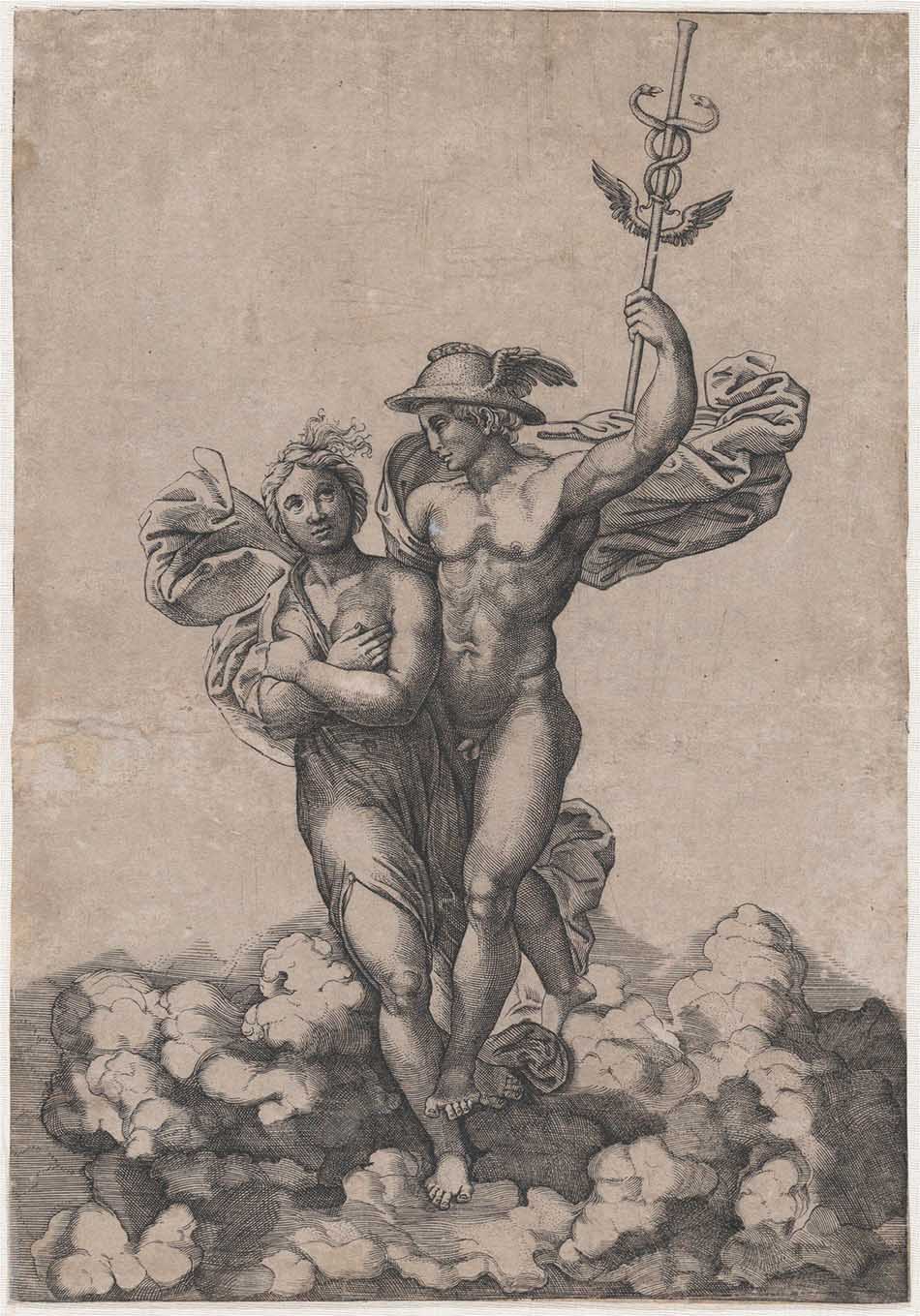
Gian Jacopo Caraglio after Raphael,
“Mercury and Psyche”,
c. 1520–1527,
Engraving,
sheet: 25.3 x 17.7 cm
(9 15/16 x 6 15/16 in.)
The Metropolitan Museum of Art,
Purchase, Joseph Pulitzer Bequest, 1917
© The Metropolitan Museum of Art / Art Resource, NY
 Statement
Statement
Earl A. Powell III, director, National Gallery of Art
“This exhibition provides an unprecedented opportunity to examine the extent and depth of prints, plaquettes, and maiolica in the Gallery’s collection,”
“The visual links between these objects vividly demonstrate that Renaissance prints, produced in large numbers and rapidly diffused, were among the earliest viral images in European art.
We are grateful for a grant from the Eugene V. and Clare E. Thaw Charitable Trust, which made it possible to explore the complex and unpredictable connections shared between these works of art.”
Curator: The exhibition is curated by Jamie Gabbarelli, assistant curator of prints, drawings, and photographs at the Rhode Island School of Design Museum. The exhibition is the culmination of Gabbarelli’s research as the Andrew W. Mellon Postdoctoral Curatorial Fellow in the department of old master prints from 2015 to 2017.
Exibition Catalogue. The exhibition is accompanied by an illustrated 156-page catalog featuring a preface by Jonathan Bober, Andrew W. Mellon Senior Curator of Prints and Drawings at the National Gallery of Art, Washington, and essays by exhibition curator Jamie Gabbarelli.The catalog is available for purchase in the West Building, Concourse, and East Building Shops; shop.nga.gov; (800) 697-9350 (phone); (202) 789-3047 (fax); or [email protected].
NATIONAL GALLERY OF ART, Washington
6th and Constitution Avenue NW, Washington, DC 20565
Telephone: (202) 737-4215 Accessibility Information: (202) 842-6905
http://www.nga.gov/
Hours: Monday–Saturday, 10 a.m.–5 p.m. Sunday, 11 a.m.–6 p.m.